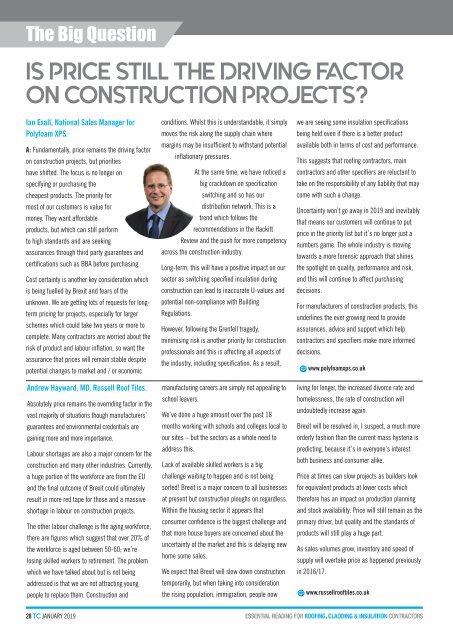January 2019
Create successful ePaper yourself
Turn your PDF publications into a flip-book with our unique Google optimized e-Paper software.
The Big Question<br />
IS PRICE STILL THE DRIVING FACTOR<br />
ON CONSTRUCTION PROJECTS?<br />
Ian Exall, National Sales Manager for<br />
Polyfoam XPS.<br />
A: Fundamentally, price remains the driving factor<br />
on construction projects, but priorities<br />
have shifted. The focus is no longer on<br />
specifying or purchasing the<br />
cheapest products. The priority for<br />
most of our customers is value for<br />
money. They want affordable<br />
products, but which can still perform<br />
to high standards and are seeking<br />
assurances through third party guarantees and<br />
certifications such as BBA before purchasing.<br />
Cost certainty is another key consideration which<br />
is being fuelled by Brexit and fears of the<br />
unknown. We are getting lots of requests for longterm<br />
pricing for projects, especially for larger<br />
schemes which could take two years or more to<br />
complete. Many contractors are worried about the<br />
risk of product and labour inflation, so want the<br />
assurance that prices will remain stable despite<br />
potential changes to market and / or economic<br />
Andrew Hayward, MD, Russell Roof Tiles.<br />
Absolutely price remains the overriding factor in the<br />
vast majority of situations though manufacturers’<br />
guarantees and environmental credentials are<br />
gaining more and more importance.<br />
Labour shortages are also a major concern for the<br />
construction and many other industries. Currently,<br />
a huge portion of the workforce are from the EU<br />
and the final outcome of Brexit could ultimately<br />
result in more red tape for those and a massive<br />
shortage in labour on construction projects.<br />
The other labour challenge is the aging workforce,<br />
there are figures which suggest that over 20% of<br />
the workforce is aged between 50-60; we’re<br />
losing skilled workers to retirement. The problem<br />
which we have talked about but is not being<br />
addressed is that we are not attracting young<br />
people to replace them. Construction and<br />
conditions. Whilst this is understandable, it simply<br />
moves the risk along the supply chain where<br />
margins may be insufficient to withstand potential<br />
inflationary pressures.<br />
At the same time, we have noticed a<br />
big crackdown on specification<br />
switching and so has our<br />
distribution network. This is a<br />
trend which follows the<br />
recommendations in the Hackitt<br />
Review and the push for more competency<br />
across the construction industry.<br />
Long-term, this will have a positive impact on our<br />
sector as switching specified insulation during<br />
construction can lead to inaccurate U-values and<br />
potential non-compliance with Building<br />
Regulations.<br />
However, following the Grenfell tragedy,<br />
minimising risk is another priority for construction<br />
professionals and this is affecting all aspects of<br />
the industry, including specification. As a result,<br />
manufacturing careers are simply not appealing to<br />
school leavers.<br />
We’ve done a huge amount over the past 18<br />
months working with schools and colleges local to<br />
our sites – but the sectors as a whole need to<br />
address this.<br />
Lack of available skilled workers is a big<br />
challenge waiting to happen and is not being<br />
sorted! Brexit is a major concern to all businesses<br />
at present but construction ploughs on regardless.<br />
Within the housing sector it appears that<br />
consumer confidence is the biggest challenge and<br />
that more house buyers are concerned about the<br />
uncertainty of the market and this is delaying new<br />
home some sales.<br />
We expect that Brexit will slow down construction<br />
temporarily, but when taking into consideration<br />
the rising population, immigration, people now<br />
we are seeing some insulation specifications<br />
being held even if there is a better product<br />
available both in terms of cost and performance.<br />
This suggests that roofing contractors, main<br />
contractors and other specifiers are reluctant to<br />
take on the responsibility of any liability that may<br />
come with such a change.<br />
Uncertainty won’t go away in <strong>2019</strong> and inevitably<br />
that means our customers will continue to put<br />
price in the priority list but it’s no longer just a<br />
numbers game. The whole industry is moving<br />
towards a more forensic approach that shines<br />
the spotlight on quality, performance and risk,<br />
and this will continue to affect purchasing<br />
decisions.<br />
For manufacturers of construction products, this<br />
underlines the ever growing need to provide<br />
assurances, advice and support which help<br />
contractors and specifiers make more informed<br />
decisions.<br />
www.polyfoamxps.co.uk<br />
living for longer, the increased divorce rate and<br />
homelessness, the rate of construction will<br />
undoubtedly increase again.<br />
Brexit will be resolved in, I suspect, a much more<br />
orderly fashion than the current mass hysteria is<br />
predicting, because it’s in everyone’s interest<br />
both business and consumer alike.<br />
Price at times can slow projects as builders look<br />
for equivalent products at lower costs which<br />
therefore has an impact on production planning<br />
and stock availability. Price will still remain as the<br />
primary driver, but quality and the standards of<br />
products will still play a huge part.<br />
As sales volumes grow, inventory and speed of<br />
supply will overtake price as happened previously<br />
in 2016/17.<br />
www.russellrooftiles.co.uk<br />
28 TC JANUARY <strong>2019</strong>

















